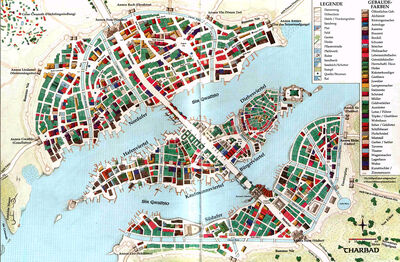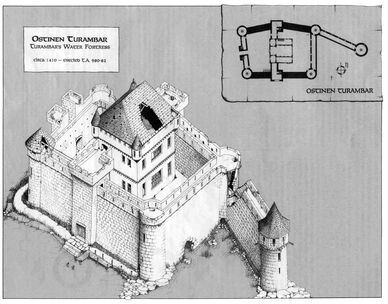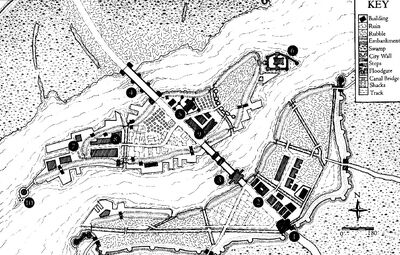Tharbad was a city on the southern edge of Eriador, far up along the once densely forested banks of the Gwathló, and so straddling the border of the regions Enedwaith and Minhiriath.
Geography[]

The City of Tharbad ca. 1409 TA
The land of Tharbad was almost flat, with sluggish waters tending to spread into fen-land. Above Tharbad the river forked, with both branches having converged from out of a network of swamps, pools and eyots. It was populated by swans, and many other waterfowl. This huge fen-land north-east of Tharbad, which the elves named "Nîn-in-Eilph".
Climate[]
Like most of Cardolan, the climate of Tharbad itself is moderate. Summers are seldom unbearably hot, but the humidity can be bothersome. The snowfalls of winter are never heavy and do not accumulate in the marshes and swamps, which rarely freeze over. North winds can be quite damaging, particularly to the relatively unprotected island portion of the city. The Gwathló has been known to rise considerably, especially during the spring rainy season.
Second Age[]
In the early Second Age the 'Swanfleet' entered the southern part of the Noldorin realm Eregion. In the sixth century of that Age Tar-Aldarion went much on land as well as sea, and went up the River Gwathló as far as Tharbad, and there met Galadriel.
Such early river voyages were also made by hardy explorers of Númenor, in ships of smaller draught,[3] but such journeys up the Gwathló increased rapidly after the Númenóreans constructed a small harbour at the river's estuary to exploit the local timber: 'Vinyalondë', 'the New Haven'.
By S.A. 1695, the Númenóreans were devastating the forests below Tharbad, and had been obliged to build forts both at the Haven and along the river, to protect their ship-building yards and wood-stores from the local population, who were understandably hostile, being treated as enemies.[1]
Despite overrunning all of Eriador in the war which began in that year, Sauron's armies had eventually been forced back to the fortified River Gwathló, where they were held. Beforehand, Sauron had not enough force to spare for any assault upon the forts, but late in the war he had summoned more forces, which were approaching from the south-east, and were indeed in Enedwaith at the Crossing of Tharbad, which was only lightly held.[1]
Whether Tharbad's defences - which presumably consisted of the most northerly of the Gwathló's river forts - were overcome is uncertain, but Tharbad did become the site of The Battle of the Gwathló, where after having his army caught in the rear by Ciryatur, who had hurried up the Gwathló from Lond Daer, "Sauron was routed utterly…"[3]
Tharbad is not mentioned in surviving records for more than 1500 years after the war: the whole region was largely ignored by the elves and the Númenóreans following the destruction of Eregion and the forests "and the continued hostility of the surviving natives."
Third Age[]
Tharbad about T.A. 1409[]
Tharbad ca. T.A. 1409:
- Type: Walled City.
- Inhabitants: 60% Cardolandrim, 20% Dunman, 10% Northman, 5% Eriadoran, 5% Other Mannish.
- Population: 21,345.
- Origin: A Númenórean river port dating to the mid-Second Age.
- Purpose: A major urban hub; the effective administrative center of Cardolan; an outpost of Gondorian authority; the focus of trade in Eriador.
- Symbol : A Red Hill surrounded by Seven Stars.
In T.A. 1409, the last King and army of Cardolan were been slain on the Barrow downs, and the Regent Nimhir and the Gondorian Hando Ciramir had to cope with a wave of refugees and a possible famine. Since the fall of King Osthir of Cardolan , the former Númenorean port of Tharbad had declined from the glory it held in ages past.

The Docks of Tharbad
Recently, frequent flooding has contributed to the number of abandoned buildings and dilapidated docks along the river. These areas have proven likely haunts for the lowlife whose presence is only obscured by the dense fog that lifts and settles daily in Tharbad.
Tharbad is divided into quarters and districts by its canals and major thoroughfares; directions given by the inhabitants will name these districts first, before the speaker names a street or building. Aside from the tolls and guards at the north and south gates, it is relatively easy to roam Tharbad unnoticed. The great dike, the Rammas Nin, that protects the city from flooding, serves to channel traffic into the major causeways and roads, but it is not tall or well patrolled; any fugitive or smuggler who doesn't mind wading the swamps can cross into or out of the Tharbad at little risk. If trouble does arise, the city authorities post guards along the Menatar Romen and put roadblocks on the two main bridges over the Gwathló. Snitches and people wishing to locate lost friends and "business associates" would be advised to do the same.
The South Bank[]
The South Bank was once considered the oldest portion of the city, and the Annon Harn (S. "South Gate") stands on the site where Prince Aldarion of Númenor first constructed a tower back in the Second Age. After serving as a Dunnish slum for most of the early Third Age, it was refurbished to provide space for the wool trade and the Gondorian merchants coming up the "Land Road" through Dunfearn. Later, Gondorian soldiers followed the same route to protect the trade routes as Cardolan fell into chaos. The Annon Harn controls entry into the city along the Old South Road. It is open 24 hours a day, but the entry is manned by watchmen who turn away undesirables and exact tolls. The other gates are also manned, but do not remain open at all hours. They are typically favored by the locals, and their watchmen charge tolls only to strangers. The toll is 2 Pennies, plus a surcharge for any significant merchandise that might look saleable. The South Bank is the bastion of the Weavers' and Dyers' Guilds. Most of the Gondorian garrison resides here, as do most government officials. Such prosperous neighbors have made the better homes here popular with the city's merchants.
The Island[]
The four districts on Tol Gelin in midstream of the Gwathló are collectively known to the people simply as "The Island." It is the commercial and mercantile center of the city. Expansion to the islet from the small trading town on the south bank began in the middle of the Second Age with the construction of the now-ruined fortifications on its northern end. The ruins are the undisputed domain of the thieves of Tharbad (known in the city officially as the "Traders Guild"), and the southern tip belongs to the Bargemen of the Gwathló. The central section is neutral ground, inhabited by merchants, factors, and ship owners west of the main road and the common folk who serve them on the east side. All factions in the city realize that business must continue. Traffic on the Gwathló is heavy, and river-traders are assessed a tariff on specific goods which pass through the docks. At times, the taxes can be high, but may be avoided altogether by purchasing a license from Hallas the Harbormaster for 10 gold pieces; it is good for one year.
The North Bank[]
The North Bank is the newest section of Tharbad, having been built by first Prince and then expanded by King Thorondûr in the ninth century of the Third Age. The east end of the North Bank is the stronghold of the lesser guilds. The Glassblowers, in particular, populate the downstream side of the North Bank, led by the Calenmiri, immigrants from Fornost in the original days of the expansion. The Saluters control the riverbank, and the Laborers hold the scarcely rebuilt west end. The central area of the North Bank is probably the safest area for travelers. The Annon Forn, or North Gate, is open from dawn to dawn and charges tolls in the same manner as the South Gate.
King's House[]
The King's Row is located along the great avenue of the Menetar. One of its most significant sites is the King's house on the Island. The walled gardens surrounding the turreted manor border both the boulevard and the Sir Gwathló. In T.A. 1409, the King's House is occupied by Regent Numhir and Princess Nirnadel whenever they are present in Tharbad. The Council of the Scepter meets in its Great Hall. In T.A. 1643, the domicile has been long abandoned and looted. Only children and vagabonds sneak into the ruin, either over the walls or across the dike alongside the river. It is haunted by what is said to be the ghost of Princess Nirnadel. Actually, the "ghost" is a Faerie being, a wood-spirit from the Old Forest whose tree was cut down and used as the back-board for a series of landscape paintings. The essence of Tathariel, the wood-spirit, is in each of the paintings; and each has, over the years, changed so as to show her face. One special painting, hidden somewhere in the walls of the King's House, binds Tathariel to the spot. She will haunt the place until she can persuade someone to locate that painting and buy or steal the rest of them for her. Tathariel is awaiting for someone other than a thief, beggar, or illiterate squatter to sneak into the King's House. Someone bright enough to figure out that she is not a ghost would be a prime candidate for the task of saving her. She knows the location of valuable treasures that would be ample reward for anyone undertaking her quest; however, if the person who stumbles across her is of bad character, she may just bind him to her cause by embedding a sliver of wood in his chest next to his heart and promising to make it grow if she is betrayed. Tathariel is detached and dreamy, after the manner of wood-spirits, and subject to temper-tantrums. She can talk for hours on any subject; some of what she says might be useful historical or political information. She does not actually intend to slay or injure anyone with her wood slivers or her haunting—which consists mainly of strange noises and visions—but if she is angered by evil deeds or bad faith she is capable exacting a harsh and terrifying vengeance.
The Shantytowns[]
Outside the dikes and gates on the north side of the river are the shantytowns, an expression of the miseries afflicting the rest of Cardolan. Consisting of hastily constructed shacks and drainage ditches, the locale is horribly overcrowded with refugees from the wars, and disease is rampant. Only a few healers and volunteers from the religious orders are available to tend the sick—and the Canótaran and Mayor have few resources available to support a public dole.
Tharbad's Sewers[]

Tharbad Sewers Map
Tharbad's original sewer system, built by the Dúnedain, runs under what is now the Thieves' Quarter and adjacent areas. Other newer drains have been constructed, but they are not as complete of elaborate. The main tubes (running directly from riverside drains) are generally 7 feet in diameter, and possess a trough in the center to carry water during low runoff periods, yet leaving a flat walkway on either side. The side tunnels are 5 feet in diameter and perfectly round. Some connect with street grates and gutters by way of shafts 3 feet in diameter, with built-in iron-alloy ladders. Other shafts are smaller and not accessible to people. All shafts are usually 15-20 feet deep, permitting the sewers to run at least 15 feet below street level. All street grates are a remarkable alloy which has survived almost intact through the centuries since the city's construction. The grates of the lower sewer sections cannot boast the same quality, and many are dangerous to tread upon. They weigh about 50 pounds. The large grates which cover the riverside drains are in even poorer repair; most have a section missing or are gone altogether. Since these are waste and storm sewers, there is an ever-present, noxious odor, there is a chance that any fire brought into the sewer will ignite explosive swamp/waste gases.
Water level in the sewers[]
Side Tunnels Main Tubes Riverside Drains Spring 6 inches-1 foot 1-2 feet 2*3 feet Summer 1-6 inches 6 inches-1 foot 18 inches-2 feet Fall 1-3 inches 3-6 inches 1-2 feet Winter 1-3 inches 3-9 inches 1-3 feet
Ostínen Turambar[]

The fortress was once a lordly manor, but has long since fallen into a hopeless ruin. Below is a brief description of the layout of the castle, its present condition, and inhabitants.
Circular Towers: All towers have basically the same design: three stories high with a stone spiral staircase connecting all floors. They vary in degree of dilapidation. Central Keep. The ground floor holds the Great Hall, twin guardrooms just inside the west doors, a kitchen to the south, and a stair hall to the north. The second floor guest chambers and the upper portion of the Great Hall. The lord's quarters occupied the third floor.
North Wing: The upper levels have collapsed into the lower floors. The wing is uninhabitable. South Wing. The most intact portion of the fortress, this is where Barnur and his gang have their refuge. Their loot is stored on the second floor in a chest. It holds 200 gold pieces, 850 silver pieces, and jewelry worth 300 gold pieces.

Gargoyle Tower - Floorplans
Gargoyle Tower:This four-story tower served as a lookout point in the days when Ostinen Turambar was a garrisoned fortress. Now it has fallen into ruin, and rumors abound that it is haunted by undead spirits from the swamps. The tower is not haunted, but the legends alone are enough to keep Barnur the ruffian and his men out of the place most of the time. As can be seen on the map insert accompanying the castle view, the tower is connected to the rest of the fortification by a wall within which runs a hallway. This interior access to the tower is dangerous, however. Each time someone passes through the hall, there is a chance the ceiling will collapse .
The alternate way to the tower is a narrow strip of land (sand and mud, actually) running along the north edge of the castle all the way out to the tower. It is usually no more than three feet wide, and after a heavy rain it disappears altogether. From this uncertain path, one can enter the Gargoyle Tower through a rent in the stones where the curtain wall abuts the tower.
Level One: One can enter through a door (#1), which opens into the adjacent hallway. The door is relatively intact. Another door (#2) remains in place, but any attempt to open it may simply destroy its corroded hinges , causing the portal to fall into the river. Several flags of the tower's stone floor are cracked. Broken remains of furniture are strewn across the entire space. In the chamber's center, a stone spiral staircase rises intact to the second floor.
Level Two: A wood dividing wall has rotted so extensively that leaning against it may bring the barrier down. The door into the hallway on the second level of the adjacent curtain wall is virtually gone. The spiral stair continues to the third floor, but, although structurally sound, it is broken in several places and will require careful maneuvering from any who ascend .
Level Three: The door connecting the tower and the curtain wall is intact and thoroughly jammed. A hidden compartment (Sheer Folly to find) is located next to the door. The compartment is locked and contains a tiara stolen from Lothiriel. A rusty ladder gives access to the observation level above. There is a chance that any given rung will break when subjected to a climber's weight.
Level Four: The observation level boasts an array of windows facing in every direction. The door to the adjoining curtain wall is intact, but opens onto empty air. The floor is littered with bird droppings.
Tharbad in later Times[]

The Ruins of Tharbad in the early fourth Age (Beginning of the rebuilding)
In T.A. 1643, the Great Plague and the twin invasions of Warlord Ardagor and the Barrow-wights created a similar crisis. Nonetheless, Tharbad still dwarfed any other urban center in Eriador. The petty rivalries among Cardolan's surviving Princes manifested themselves as brawls between various guilds and factions in Tharbad. The thieves of the city grew in might and boldness with each passing season, and Plague refugees provided yet another headache for the city's administrators. Gondor's appointed officer, the Canótaran , kept the peace as well as he could, but the city seemed destined to tear itself apart. Only Tharbad's status as the chief trading center for all lands north of Gondor kept the city alive. Goods from throughout Middle-earth passed through Tharbad en route to the wealthy households of Cardolan and Arthedain , but little of the wealth seemed to find it's way to the homes of Tharbad's poor citizens.
A disastrous winter in TA 2911 added to the populace fleeing the already declined city and in Spring TA 2912 terrible floods sealed it's final end. With the populace fled only ruins, half-sunk in the swamp-lands, remained, becoming hideouts for Waylayers and Outlaws. After the Fell Winter of T.A. 2912 Tharbad was devastated by great Floods and eventually given up and deserted by it's last inhabitants.The Great Bridge fell apart and the Area became a marshland, uninhabited except for a few minor hamlets or lone cottagers. The area had a bad reputation as the local Tribesmen were unfriendly and the ruins were said to serve as hideouts for Brigands who infested the old North-South Road.
Places of Note[]
- Decrepit Rooftops
- The Empty Mug
- Hidden Alleyway
- Marsh-Village
- The Passage
- Ruined Bridge
- Ruins of the Second Age
- The Seedy Inn
- Sewer-Swamps
- Tharbad Landing
- Tharbad Hideout
People of Note[]

Dírhavel the Alchemist (ca. T.A. 1409)
Before T.A.ca. 1640[]
Barnur the Ruffian Bellach Ciramir Daggais Dírhavel Hallas the Harbormaster Lothíriel Nalir Nimhir Nirnadel Numhir Osthir Tathariel Thorondur
Sources[]
- ICE MERP #2005: Arnor
- ICE MERP #8050: Thieves of Tharbad
